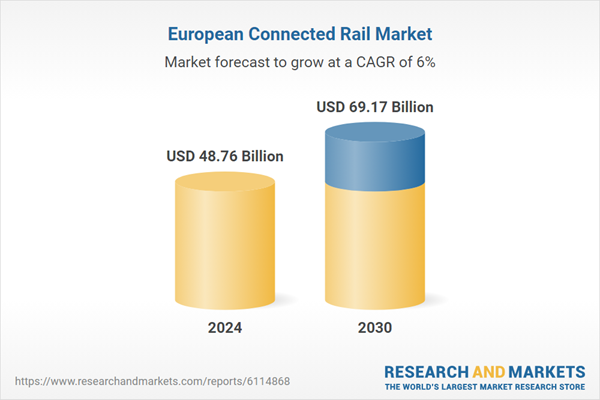Free Webex Call
The Europe Connected Rail Market was valued at USD 48.76 Billion in 2024, and is expected to reach USD 69.17 Billion by 2030, rising at a CAGR of 6%. The Europe Connected Rail market is witnessing transformative growth fueled by the integration of advanced digital technologies in rail systems. The increasing adoption of communication-based train control (CBTC), positive train control (PTC), and automated train operation (ATO) is streamlining operations and boosting efficiency. Speak directly to the analyst to clarify any post sales queries you may have.
10% Free customizationThis report comes with 10% free customization, enabling you to add data that meets your specific business needs.
Governments and rail operators are investing heavily in digital signaling, predictive maintenance solutions, and centralized traffic management systems to ensure higher safety and reduced downtime. As aging rail infrastructure undergoes digital upgrades, there's growing emphasis on improving interoperability across networks through standardized communication protocols and data-sharing frameworks. These advancements are enabling real-time diagnostics, optimizing fleet performance, and minimizing service disruptions.
Market Drivers
Rising Urbanization and Demand for Efficient Transportation
With increasing urban populations, there's a growing need for efficient and reliable public transportation systems. Connected rail solutions offer enhanced capacity, punctuality, and passenger experience, making them a preferred choice for urban commuters. The demand for seamless integration with other modes of transport is also a critical driver, facilitating the development of multimodal transport systems.Digital platforms now coordinate timetables, ticketing, and transfers across different mobility services. Automated metro lines are reducing human error and streamlining throughput in urban corridors. Cities are prioritizing rail over road transport to address congestion and lower emissions. Journey planning apps are leveraging rail APIs to give commuters dynamic routing options. Infrastructure upgrades are emphasizing connectivity between central business hubs and residential zones.
Key Market Challenges
High Implementation Costs
The initial investment required for implementing connected rail systems can be substantial, including infrastructure upgrades, hardware installation, and system integration. This poses a financial challenge for some rail operators and governments. Budget constraints often delay or phase out digital modernization plans. Smaller cities or low-density areas struggle to justify the return on investment. Advanced systems require costly skilled labor for deployment and testing. Maintenance contracts and technology licensing add to the total expenditure over time. Financial uncertainty in the rail industry can limit long-term capital commitments for digital transformation.Key Market Trends
Adoption of Digital Twin Technology
Digital twin technology is revolutionizing connected rail systems by creating real-time, virtual replicas of physical rail infrastructure and equipment. These digital models enable rail operators to simulate, monitor, and analyze assets such as tunnels, bridges, stations, and rolling stock. By integrating sensor data and predictive analytics, digital twins can detect early signs of mechanical stress, material fatigue, or environmental degradation. This predictive maintenance capability reduces downtime, increases safety, and improves asset longevity. The ability to simulate infrastructure responses to various stressors - such as heavy traffic, extreme temperatures, or seismic activity - allows for preemptive repairs and resource allocation.Key Market Players
- Trimble, Inc.
- Hitachi Limited
- Siemens AG
- IBM Corporation
- Cisco Systems, Inc
- Wabtec Corporation
- Tech Mahindra Limited
- Calamp Corp.
- Nokia Corporation
- Huawei Investment & Holding Co., Ltd
Report Scope:
In this report, the Europe Connected Rail Market has been segmented into the following categories, in addition to the industry trends which have also been detailed below:Europe Connected Rail Market, By Services:
- Passenger Mobility & Services
- Passenger Information System (PIS)
- Automated Fare Collection System
- IP Video Surveillance
- Train Tracking & Monitoring Solutions
- Others
Europe Connected Rail Market, By Rolling Stock Type:
- Electric Multiple Unit (EMU)
- Diesel Locomotive
- Passenger Wagons
- Light Rail/Tram Car
- Electric Locomotive
- Freight Wagons
- Others
Europe Connected Rail Market, By Safety & Signalling System:
- Positive Train Control
- Automated/Integrated Train Control (ATC)
- Communication/Computer-Based Train Control (CBTC)
Europe Connected Rail Market, By Country:
- France
- United Kingdom
- Italy
- Germany
- Spain
- Belgium
- Switzerland
- Netherlands
Competitive Landscape
Company Profiles: Detailed analysis of the major companies present in the Europe Connected Rail Market.Available Customizations:
With the given market data, the publisher offers customizations according to the company’s specific needs. The following customization options are available for the report.Company Information
- Detailed analysis and profiling of additional market players (up to five).
This product will be delivered within 1-3 business days.
Table of Contents
1. Introduction
2. Research Methodology
3. Executive Summary
4. Europe Connected Rail Market Outlook
5. France Connected Rail Market Outlook
6. United Kingdom Connected Rail Market Outlook
7. Italy Connected Rail Market Outlook
8. Germany Connected Rail Market Outlook
9. Spain Connected Rail Market Outlook
10. Belgium Connected Rail Market Outlook
11. Switzerland Connected Rail Market Outlook
12. Netherlands Connected Rail Market Outlook
13. Market Dynamics
16. Competitive Landscape
Companies Mentioned
- Trimble, Inc.
- Hitachi Limited
- Siemens AG
- IBM Corporation
- Cisco Systems, Inc
- Wabtec Corporation
- Tech Mahindra Limited
- Calamp Corp.
- Nokia Corporation
- Huawei Investment & Holding Co., Ltd
Table Information
| Report Attribute | Details |
|---|---|
| No. of Pages | 135 |
| Published | July 2025 |
| Forecast Period | 2024 - 2030 |
| Estimated Market Value ( USD | $ 48.76 Billion |
| Forecasted Market Value ( USD | $ 69.17 Billion |
| Compound Annual Growth Rate | 6.0% |
| Regions Covered | Europe |
| No. of Companies Mentioned | 10 |









